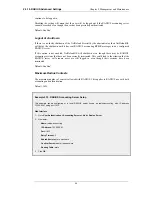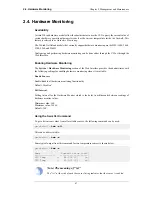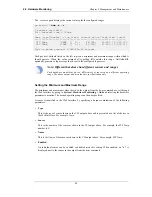
Web Interface
1.
Go to Objects > Address Book
2.
Click on the Add button
3.
In the dropdown menu displayed, select IP Address
4.
In the Name text box, enter myhost
5.
Enter 192.168.10.10 in the IP Address textbox
6.
Click OK
7.
Verify that the new IP4 address object has been added to the list
Example 2.7. Deleting a Configuration Object
This example shows how to delete the newly added IP4Address object.
Command-Line Interface
gw-world:/> delete Address IP4Address myhost
Web Interface
1.
Go to Objects > Address Book
2.
Right-click on the row containing the myhost object
3.
In the dropdown menu displayed, select Delete
The row will be rendered with a strike-through line indicating that the object is marked for deletion.
Example 2.8. Undeleting a Configuration Object
A deleted object can always be restored until the configuration has been activated and committed. This example
shows how to restore the deleted IP4Address object shown in the previous example.
Command-Line Interface
gw-world:/> undelete Address IP4Address myhost
Web Interface
1.
Go to Objects > Address Book
2.
Right-click on the row containing the myhost object
3.
In the dropdown menu displayed, select Undo Delete
Listing Modified Objects
After modifying several configuration objects, you might want to see a list of the objects that were
changed, added and removed since the last commit.
2.1.9. Working with Configurations
Chapter 2. Management and Maintenance
54
Summary of Contents for DFL-1600 - Security Appliance
Page 27: ...1 3 NetDefendOS State Engine Packet Flow Chapter 1 NetDefendOS Overview 27 ...
Page 79: ...2 7 3 Restore to Factory Defaults Chapter 2 Management and Maintenance 79 ...
Page 146: ...3 9 DNS Chapter 3 Fundamentals 146 ...
Page 227: ...4 7 5 Advanced Settings for Transparent Mode Chapter 4 Routing 227 ...
Page 241: ...5 4 IP Pools Chapter 5 DHCP Services 241 ...
Page 339: ...6 7 Blacklisting Hosts and Networks Chapter 6 Security Mechanisms 339 ...
Page 360: ...7 4 7 SAT and FwdFast Rules Chapter 7 Address Translation 360 ...
Page 382: ...8 3 Customizing HTML Pages Chapter 8 User Authentication 382 ...
Page 386: ... The TLS ALG 9 1 5 The TLS Alternative for VPN Chapter 9 VPN 386 ...
Page 439: ...Figure 9 3 PPTP Client Usage 9 5 4 PPTP L2TP Clients Chapter 9 VPN 439 ...
Page 450: ...9 7 6 Specific Symptoms Chapter 9 VPN 450 ...
Page 488: ...10 4 6 Setting Up SLB_SAT Rules Chapter 10 Traffic Management 488 ...
Page 503: ...11 6 HA Advanced Settings Chapter 11 High Availability 503 ...
Page 510: ...12 3 5 Limitations Chapter 12 ZoneDefense 510 ...
Page 533: ...13 9 Miscellaneous Settings Chapter 13 Advanced Settings 533 ...







































